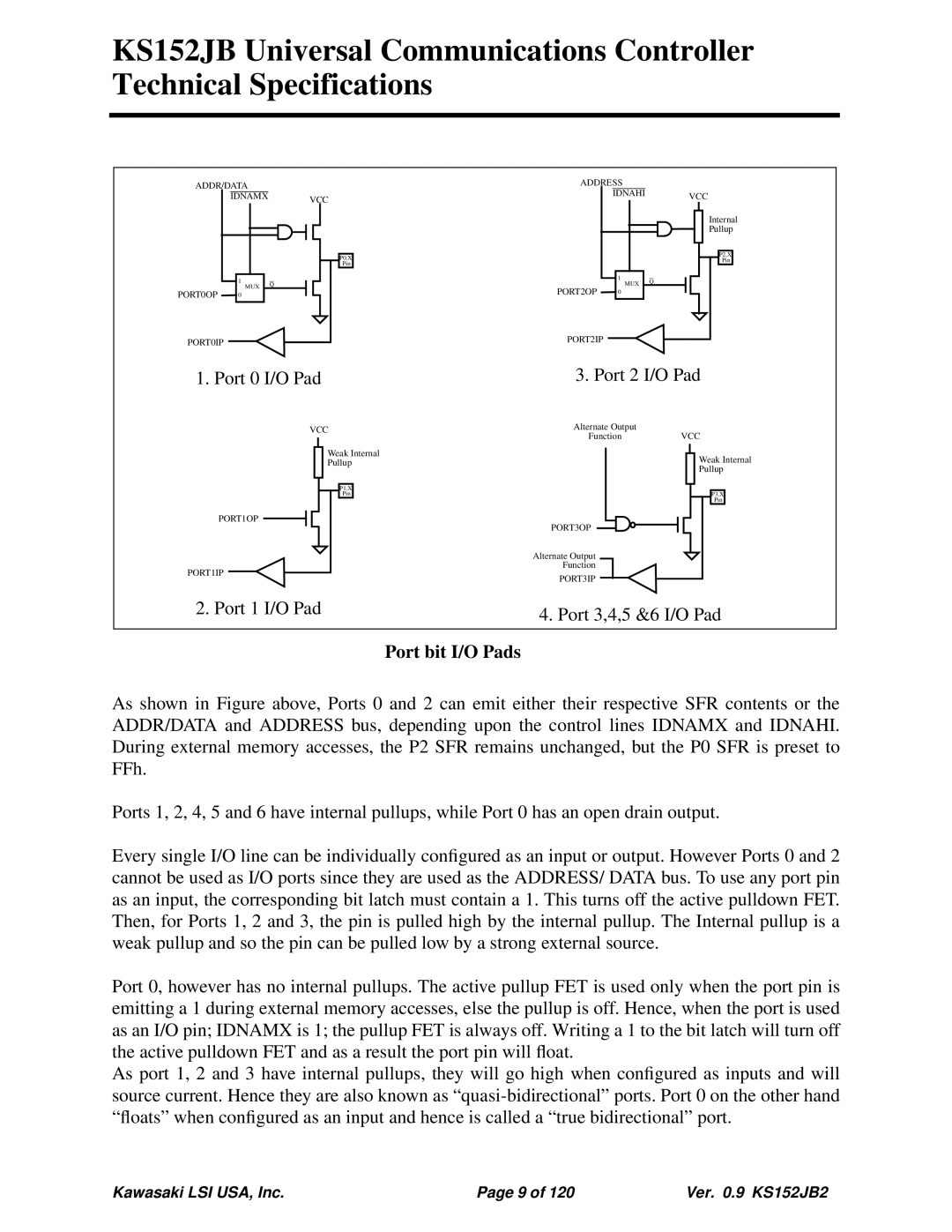
KS152JB Universal Communications Controller Technical Specifications
ADDR/DATA
IDNAMXVCC
P0.X
Pin
| 1 | MUX | Q |
|
| ||
PORT0OP |
|
| |
0 |
|
|
PORT0IP
ADDRESS
IDNAHIVCC
Internal
Pullup
P2.X
Pin
| 1 | MUX | Q |
|
| ||
PORT2OP |
|
| |
0 |
|
|
PORT2IP
1. Port 0 I/O Pad | 3. Port 2 I/O Pad |
PORT1OP
PORT1IP
VCC | Alternate Output |
|
|
|
|
|
|
| ||||||||
Function | VCC | |||||||||||||||
|
|
| Weak Internal | |||||||||||||
|
|
|
|
|
|
|
|
|
| Weak Internal | ||||||
|
|
| Pullup |
|
|
|
|
|
|
| ||||||
|
|
|
|
|
|
|
|
|
| Pullup | ||||||
|
|
|
|
|
|
|
|
|
|
|
|
| ||||
|
|
|
|
|
|
|
|
|
|
|
|
|
|
|
| |
|
|
|
| P1.X |
|
|
|
|
|
|
|
|
|
|
| |
|
|
|
| Pin |
|
|
|
|
|
|
|
|
| P3.X |
| |
|
|
|
|
|
|
|
|
|
|
|
|
|
| Pin |
| |
|
|
|
|
|
|
|
|
|
|
|
|
|
|
|
| |
|
|
|
|
|
|
|
|
|
|
|
|
|
|
|
| |
PORT3OP
Alternate Output
Function
PORT3IP
2. Port 1 I/O Pad | 4. Port 3,4,5 &6 I/O Pad |
|
Port bit I/O Pads
As shown in Figure above, Ports 0 and 2 can emit either their respective SFR contents or the ADDR/DATA and ADDRESS bus, depending upon the control lines IDNAMX and IDNAHI. During external memory accesses, the P2 SFR remains unchanged, but the P0 SFR is preset to FFh.
Ports 1, 2, 4, 5 and 6 have internal pullups, while Port 0 has an open drain output.
Every single I/O line can be individually configured as an input or output. However Ports 0 and 2 cannot be used as I/O ports since they are used as the ADDRESS/ DATA bus. To use any port pin as an input, the corresponding bit latch must contain a 1. This turns off the active pulldown FET. Then, for Ports 1, 2 and 3, the pin is pulled high by the internal pullup. The Internal pullup is a weak pullup and so the pin can be pulled low by a strong external source.
Port 0, however has no internal pullups. The active pullup FET is used only when the port pin is emitting a 1 during external memory accesses, else the pullup is off. Hence, when the port is used as an I/O pin; IDNAMX is 1; the pullup FET is always off. Writing a 1 to the bit latch will turn off the active pulldown FET and as a result the port pin will float.
As port 1, 2 and 3 have internal pullups, they will go high when configured as inputs and will source current. Hence they are also known as
Kawasaki LSI USA, Inc. | Page 9 of 120 | Ver. 0.9 KS152JB2 |
